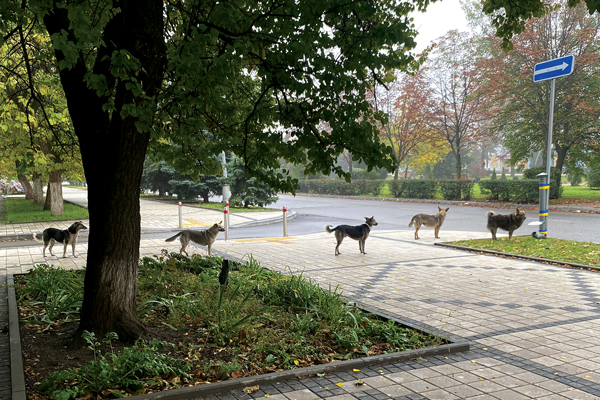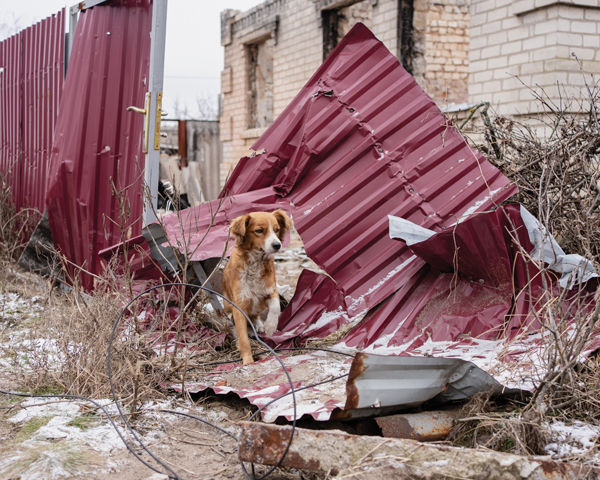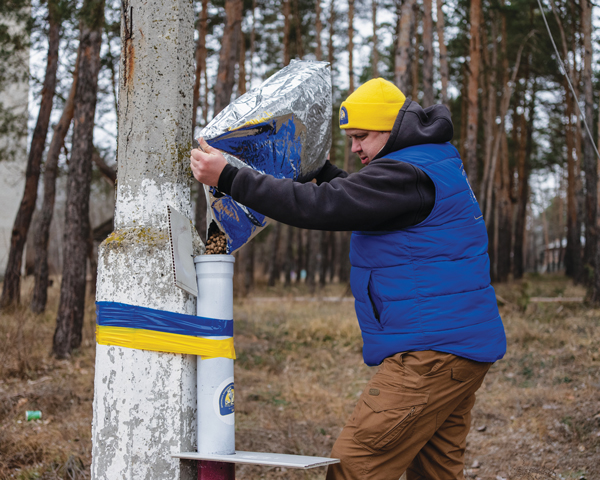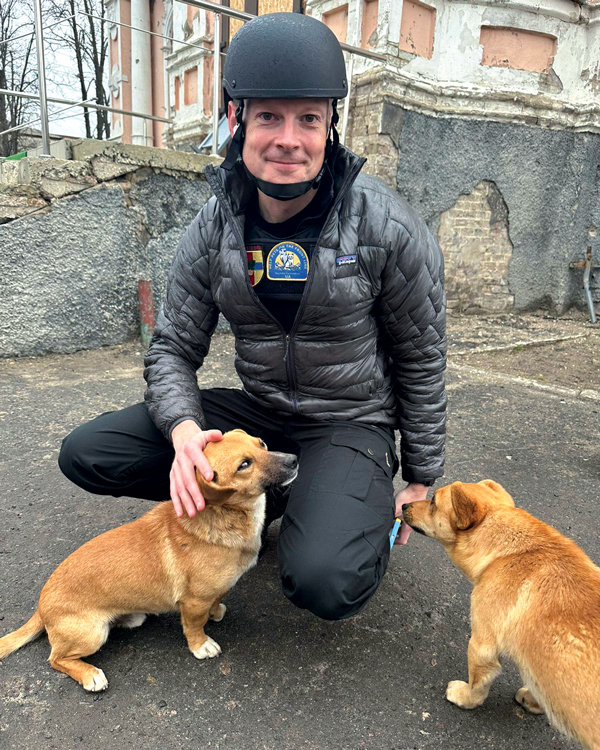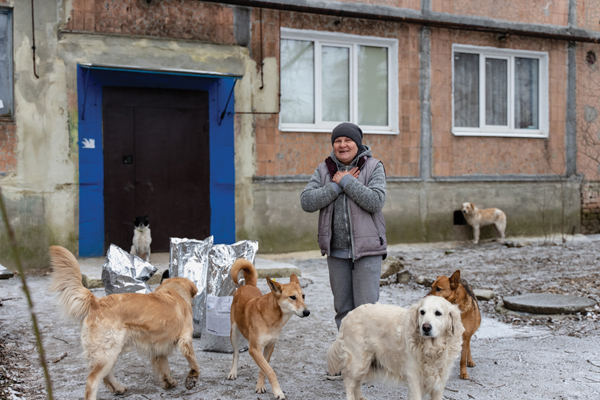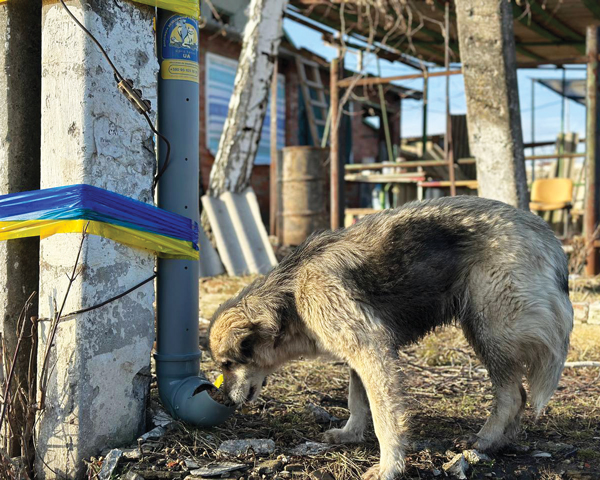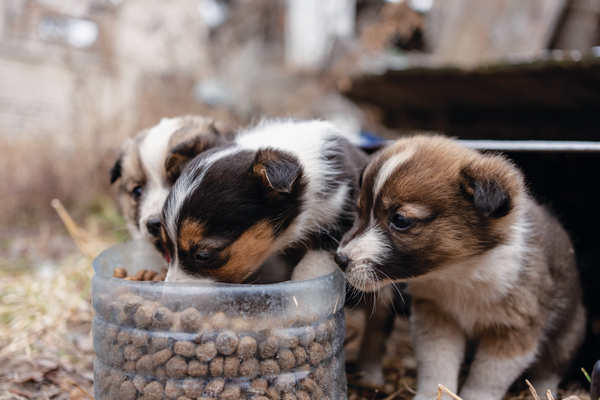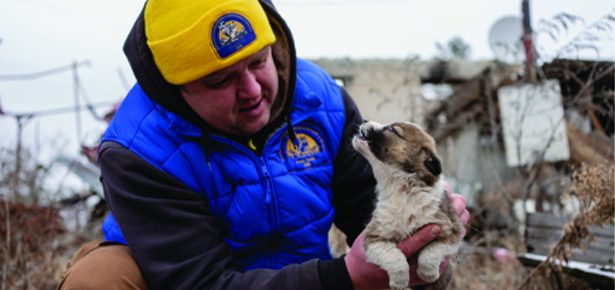
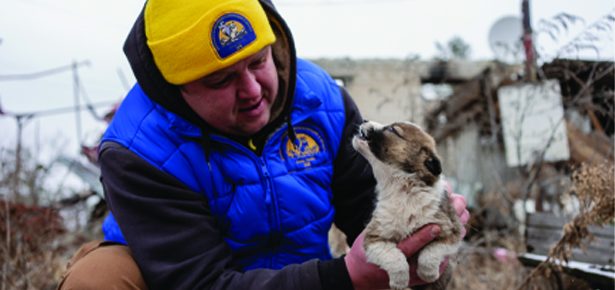
Saving the Dogs of Ukraine
Former World Central Kitchen CEO is on a mission to feed Ukraine’s displaced pets
One by one they formed a single-file line as each dog patiently waited their turn to eat from a recently constructed PVC feeding tube. Secured to a street sign with yellow and blue tape, the makeshift feeding station provided a steady stream of life-saving kibble for these hungry dogs left homeless by the war in Ukraine.
“I've never seen anything like it,” Nate Mook told me over the phone from Kramatorsk, Ukraine. “They just lined up to eat. It was so symbolic.”
Mook and members of the Ukrainian pet relief NGO Hachiko—named for the famously loyal Akita from Japan—are on a mission to help alleviate the hunger and suffering of abandoned pets in Ukraine.
Mook spent five years as CEO of José Andrés World Central Kitchen (WCK), leading its effort to feed people in disaster zones around the world. One of those places was Ukraine—
“a huge mission for the team,” he says, “and our first time navigating the complexities of working in a war zone while delivering millions of meals to those in need.”
Last August, Mook stepped down from that role, but his work in Ukraine has continued. He is now using his knowledge and experience with WCK to tackle another lifesaving endeavor: feeding pets that have been left homeless by the Russian invasion.
The ongoing war has uprooted the lives of millions of Ukrainians and caused immeasurable pain and destruction.
But it has also had a devastating effect on pets. “These are not wild, feral animals.” says Mook. “These were people's pets, and they are starving.”
Abandoned dogs in Kramatorsk, Ukraine form a single-file line waiting for their turn to eat from a PVC feeding tube constructed by the pet relief non-profit Hachiko.
An abandoned dog steps through the destruction left by fighting in the community of Svyatohirsk near the front line.
At the start of the invasion, the world watched a population in motion as millions of Ukrainians fled west to escape the onslaught of Russia’s brutal offensive. Train stations and border crossings were massed with thousands of distraught evacuees, many of them clutching their beloved pets. But many were forced to separate or leave them behind. Evacuating in the middle of a war is “extremely complicated and chaotic,” says Mook. “Packed trains and buses often had little to no room for people’s animals, especially larger dogs. People had to make awful choices during a difficult situation.”
Ukraine is home to an estimated 5.5 million cats, and nearly 750,000 dogs. There is no official record of how many dogs and cats have been evacuated out of the country. Animals are never included in official figures during war time and almost always go unaccounted for and forgotten.
Mook teamed-up with Hachiko in September 2022 and is now using his knowledge to help them scale their pet food support operations in frontline and recently liberated communities where the need is greatest. Several of the devastated towns are very close to the frontlines and “have no electricity or running water,” says Mook.
A Hachiko volunteer refills a pet feeding tube in Chasiv Yar-Bahmut, Ukraine.
"Highly traumatized by the shelling and deafening sounds of war, many of these pets are too scared to approach the food if humans are around."
“Many of the buildings and homes are heavily damaged or destroyed from the fierce fighting and occupation,” he adds. “In some cases, residents had been living underground in basements for nearly a year, relying on aid while caring for their pets.”
Based in the city of Kramatorsk located in the embattled Donetsk region, Hachiko is one of the only pet relief organizations working in these “hard-to-reach and more dangerous areas,” Mook says.
Hachiko’s founder Katya Onishchenko began helping abandoned animals at the start of the war when “hundreds of dogs and cats started appearing on the streets of our town,” says Onishchenko. “After a couple of months, we started seeing animals dying of hunger. We had to act.”
Starting in October 2022, the Hachiko team began delivering larger quantities of pet food to local residents caring for a number of homeless animals that were left behind. “We set up a call center allowing people to phone us with their pet food needs,” Mook tells me. “With pet stores closed in these liberated towns, kibble and other pet supplies are in big demand.”
Nate Mook poses with two abandoned dogs while helping homeless pets living in the communities of Ukraine’s eastern front.
Mook spoke of one of the “incredible humans” he’s met while making food deliveries. “In Sviatohirsk, we delivered several bags of pet food to a woman named Irina who spends her days taking care of a hundred stray dogs and 38 cats living around her home,” he says. Prior to Hachiko assisting her, “she was making groats and oatmeal to help feed them during occupation.”
“It’s heart-wrenching seeing these animals suffering. But at the same time, I’m so inspired by the humanity behind these efforts to help them despite going through the trauma and horrors of occupation themselves,” Mook added. With most of these animals wandering the streets, Mook and his team decided the gravity-fed feeder tubes would be the most efficient way to deliver food on a larger scale.
Highly traumatized by the shelling and deafening sounds of war, many of these pets “are sometimes too scared to approach the food if humans are around,” says Mook. “This is why the feeder stations work so well, allowing them to access the food on their own, without force.”
The Hachiko team so far has set up nearly 100 feeding stations in several cities and towns delivering over 11,000 kg of pet food. “We don’t just fill them up and leave,” says Mook. “We are supporting volunteers from the local community to manage and refill them in a way that’s efficient.”
The supplies of pet food are sourced locally through a joint partnership with Kormotech, the largest pet food manufacturer in Ukraine. Based in Lviv, Kormatech launched their Save Pets of Ukraine initiative at the start of the war and has now “delivered over 800 tons of pet food to animal welfare groups operating in Ukraine,” says Kormatech spokesperson Kateryna Kovalyuk.
A Hachiko volunteer delivers food to a local woman in Chasiv Yar-Bahmut, Ukraine who cares for a group of dogs made homeless by the war.
A homeless dog eats from a Hachiko feeding tube.
Several puppies feed from a pet feeding station set-up by the animal NGO Hachiko in Sviatohirsk, Ukraine.
This important work near the war zone doesn’t come without risk. Russian missile and artillery strikes are common in the areas where Hachiko is doing their work and conditions are very challenging. “We rely heavily on the knowledge of local partners and friends regarding our safety. Sometimes we are escorted into more hostile areas by the military and can only stay for a short time. There is always going to be risk operating in Ukraine,” Mook told me.
While recently working in the southeastern town of Orikiv, Mook and his team spotted a young dog eating from one of the Hachiko feeders, a dog Mook remembered from months early. When we first saw him, he was “skin and bones,” says Mook. Now having access to the feeders “he’s doing much better!”
With no end to the war in sight, Mook plans to remain in Ukraine and continue installing more feeders while partnering with Ukrainian veterinary groups to help provide medical care and shelter to some of the animals most in need. “I know the important role pets play for emotional support,” he says. “The pets are so connected culturally to the Ukrainian people and to this war. “It’s truly representative of the humanity that Ukraine is fighting for.”
This article originally appeared in the award-winning Modern Dog magazine. Subscribe today!
Join the newsletter and never miss out on dog content again!
"*" indicates required fields
By clicking the arrow, you agree to our web Terms of Use and Privacy & Cookie Policy. Easy unsubscribe links are provided in every email.
